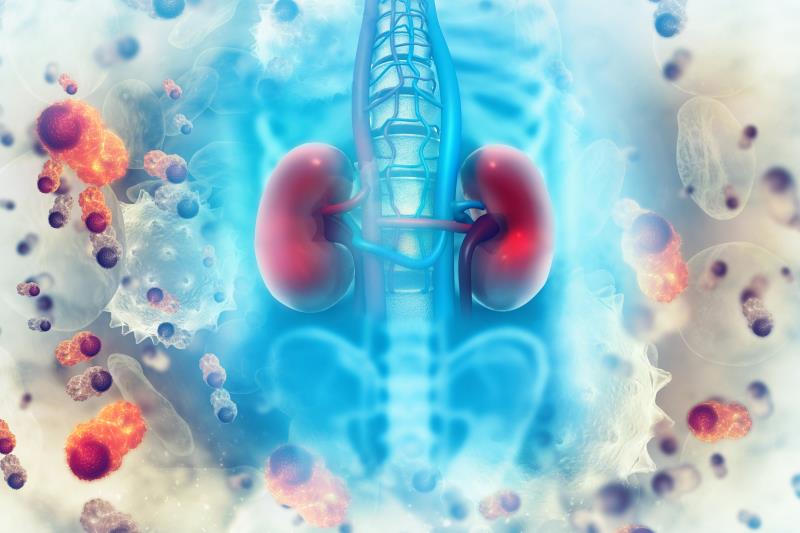
The investigational, highly selective MET inhibitor savolitinib demonstrated encouraging efficacy and safety vs standard-of-care sunitinib in patients with MET-driven*, unresectable and locally advanced, or metastatic papillary renal cell carcinoma (PRCC), according to the phase III SAVOIR trial results presented at ASCO 2020.
Despite being the most common type of non–clear cell RCC (nccRCC), there is no approved specific treatment for PRCC. [Adv Anat Pathol 2019;26:124-132; Eur Urol Oncol 2019;2:643-648] Moreover, given the various cytologic and molecular abnormalities in nccRCC vs the more dominant ccRCC subtypes, treatment outcomes in nccRCC are apparently worse if managed with ccRCC-specific regimens. [Eur Urol 2015;67:740-749; Ann Oncol 2013;24:1730-1740]
“[As such,] there remains an urgent unmet need for effective therapies [for PRCC] … As a subset of PRCC cases are MET-driven, MET inhibition may be an appropriate targeted treatment approach,” said the researchers.
Median progression-free survival (PFS) was greater with savolitinib vs sunitinib; however, between-group difference was not statistically significant (7 vs 5.6 months; hazard ratio [HR], 0.71; p=0.31). [JAMA Oncol 2020;doi:10.1001/jamaoncol.2020.2218]
“PFS rates were numerically higher at months 6, 9, and 12 [with savolitinib vs] sunitinib, hence some separation in the Kaplan-Meier curves beyond ~6 months. However, … the number of patients at risk at these points was low,” explained the researchers.
Overall survival also favoured savolitinib over sunitinib (median, not reached vs 13.2 months; HR, 0.51; p=0.11), with early separation of the Kaplan-Meier curves. Twenty-seven percent of savolitinib recipients exhibited a partial response as opposed to only 7 percent of sunitinib recipients.
Grade ≥3 adverse events were less frequent with savolitinib vs sunitinib (42 percent vs 81 percent). Compared with sunitinib-treated patients, fewer savolitinib recipients discontinued treatment (58 percent vs 67 percent), but more received subsequent therapy (36 percent vs 19 percent). “This is possibly owing to savolitinib having a better tolerability profile than sunitinib … [P]atients were more likely to be able to tolerate further treatment,” they explained.
Were the objectives MET?
While none of the endpoints achieved statistical significance, the limited efficacy data collectively favoured savolitinib over sunitinib, with the former showing superiority over the latter in terms of safety and tolerability, noted the researchers.
Sixty participants (23 percent female) were randomized 1:1 to receive oral savolitinib 600 mg QD continuously, or sunitinib 50 mg QD in 6-week cycles for 4 weeks then 2 weeks without treatment. SAVOIR was conceived under the assumption that MET-driven status in PRCC is a negative predictor for outcomes on sunitinib; however, it was prematurely terminated due to evidence suggesting otherwise. [Crit Rev Clin Lab Sci 2019;56:533-566; Oncotarget 2017;8:1046-1057; Invest New Drugs 2012;30:335-340] This, plus the small sample size, could have precluded definitive conclusions, noted the researchers.
As the current findings underscore the potential of savolitinib to improve treatment for MET-driven PRCC, a new study of the same population is being considered.
Using MET as a biomarker remains a challenge as tests detect different subsets of MET-based disease. [Cancer Res 2019;79(suppl 13):4897] “[T]herefore, it remains unclear which biomarker is the best predictor for sensitivity to MET-targeted therapies,” said the researchers.
It is also unclear which population would best benefit from MET-targeted therapy, they added. Narrowing down the definition of MET-driven status might help in identifying such patients; however, it might introduce new challenges in trial design and recruitment, and would only benefit a minority of patients, they said.
Given the growing importance of combination therapies in metastatic RCC, it would also be worth looking into the potential role of savolitinib in a combination approach in this patient subset using MET-confirmation with next-generation sequencing in a larger and longer trial, they added.